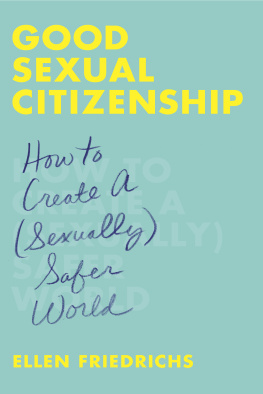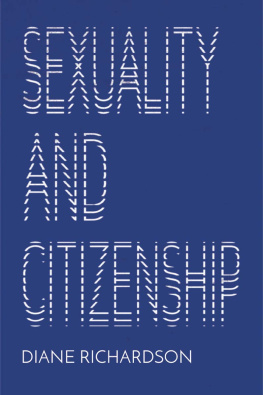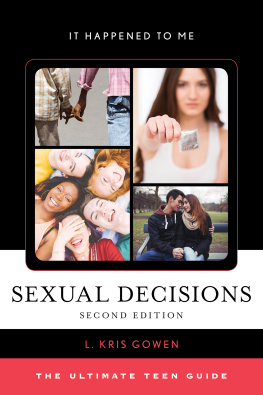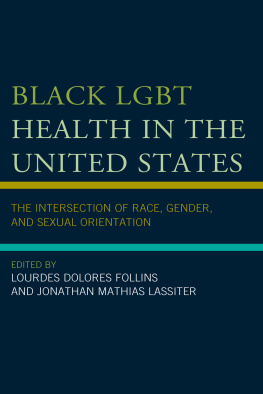ACKNOWLEDGMENTS

T his project would not have been possible without everyone at Cleis Press, particularly Hannah Bennett, who edited my work so skillfully, and Allyson Fields and Meghan Kilduff, who helped make this book a reality. I am so fortunate to have a friend like Emily Mahon who designed my amazing cover. I am deeply thankful to the many sides of my extended family for their endless support, encouragement, and babysitting (and to my kids for letting themselves be sat when I wrote!), and to my parents, who allowed me to follow my own winding path. I am incredibly grateful to the early (and not so early) readers of the manuscript, including my partner Joshua Mendelsohn, as well as Anne Conway, Jonathan Friedrichs, and Renee Harleston. I am also so honored to have been able to work professionally with such inspiring colleagues and students. Finally, credit also has to go to the public schools of Vancouver, BC, and the solid sex education I got there growing up.
CHAPTER 1

THE BASES FOR OUR BIASES
SET UP BY SEXISM
The summer after eleventh grade, I left my boyfriend Mike at home in Canada and hopped on a plane with forty other kids. We were bound for Three Rivers, Michigan, to spend six weeks doing a leadership training program at a summer camp. One of our roles as budding leaders was to run activities for the younger campers. So once a week we were assigned partners and told to come up with a thought-provoking session.
At first, most of my activities involved goofy games or baking cookies. But then I was assigned to work with a girl named Lily. Lily wore green Doc Martens, came to Three Rivers armed with a stack of books by authors I had never heard of (William S. Burroughs! Charles Bukowski! Anas Nin!), and had a great idea for an activity: we would get the kids to analyze songs to see if they were sexist.
So we collected a bunch of songs, like Guns N Roses Used to Love Her, the Beastie Boys Girls, and the Beatles Run for Your Life. Then we made a mixtape (this was the 90s, after all), got our assigned campers together, and pressed play. Afterward, we put on the punk band Fugazis Suggestion (which is possibly still the most pointedly antisexual harassment anthem ever) to counter the messages of the previous songs.
Now, I dont know if the eight-year-olds we were working with actually got a lot out of our session. But I certainly did.
Though I had led Lily to believe I was as up on this issue as she was, the idea of listening to music for the message was actually pretty new to me, though it was something that I had been thinking about more and more. Mainly, that was because of a really uncomfortable experience Id had at a concert the previous spring.
It was the Public Enemy/Anthrax show. I went with Mike and some of his guy friends. As the bands joined forces to belt out some early version of a rock/rap hybrid, three women came out on stage. They had big hair and were wearing thong bikinis and heels. They didnt sing or dance or play an instrument. Instead, they strutted around the stage as the bands encouraged the crowd to scream, Pussy! Pussy! Pussy!
I was sixteen, and aside from the models on stage, I felt like the only girl in the place. I didnt know where to look, and I wasnt sure what to do with my hands as the fist-pumping crowd around me, boyfriend included, chanted in unison.
That concert ended any interest I had in rock/rap.
However, it wasnt until Lily suggested that we dissect song lyrics that I realized just how prevalent sexism was in music and that it was possible to find bands I liked that didnt make me uncomfortable. Its not that I pored over lyric sheets before buying new music after that. But thinking about the issue definitely made me more conscious of what I listened to and which bands I wanted to support.
That event was one of my first aha moments about the very real role sexism played in my life, and in the lives of all the girls and women around me. But even though I became better and better at identifying the more blatant examples of it, like so many of us, I can still find it hard to get at the heart of what drives a lot of the more insidious, often subtle forms of gender-based discrimination that we find ourselves having to navigate as a culture.
And boy, do we still have a lot to navigate. At the same time, it can be tricky to unpack the less obvious forces driving gender bias without making people, particularly some men, feel defensive or under attack.
To a certain extent, I understand that response. I remember as a kid overhearing my mothers friend fretting about an experience at a womens rights march that she attended with her ten-year-old son: He saw a sign that said, Stop raising boys to be rapists and immediately asked if that meant he was going to grow up to be one.
Thirty years later, its not just kids trying to figure this stuff out. There are plenty of men of all ages who still have trouble when they encounter statements that dont line up with how they see themselves and their place in the world. These might be comments about how men are statistically more likely to perpetuate violence than are other groups. Or references to male privilege. Or even ads that attempt to address mens roles in issues like bullying and violence and sexual harassment.
To some people, such statements feel an awful lot like individual indictments, rather than the critiques of culture that were intended. Think about it: if someone criticizes a group you belong to, its a natural reaction to feel that person is, by implication, also criticizing you. And on the individual level, feeling defensive about such a criticism might make sense when we acknowledge that just because most violence is committed by men, that doesnt mean that most men are violent. Or that just because men tend to hold more power than women and gender minorities, practically speaking, most men arent all that powerful.
So while we try to unpack the societal forces that uphold sexism, it can help to remember that condemning a cultural system is not the same as condemning an individual person. There is no question that individuals need to be held accountable for their actions. But we can hold individuals accountable when deserved, while also critiquing a culture that encourages hostile and discriminatory behavior. This chapter looks at how gender-based discrimination and gender bias are at the heart of so much sexual hostility, and it shows how dismantling these forces can help create an overall sexually safer world for everyone who inhabits it.
ARENT WE JUST WIRED DIFFERENTLY?
Often-cited research has found different patterns of connectivity within and between the hemispheres of female and male brains.
As a result, some neuroscientific studies have been interpreted as saying that women are wired better for emotional intelligence, social skills, memory, and multitasking, while men are naturally better at perception and coordinated movement.
But even if it sounds like there is some science behind this view, we have to be careful before assuming it is fact.
Our interpretations of studies, as well as the interpretations by researchers and the media, may be influenced by gender stereotyping.
Plus, the brain adapts in the same way as a muscle: it gets larger with extra use. This means that it is possible that a womans brain may become wired for multitasking simply because society expects that of her, and so she uses that part of her brain more often. And social rewiring starts early. Segregating the way children playgiving dolls to girls and cars to boyscould be changing how our brains develop! In other words, these interests might not be natural at all.
Next page










